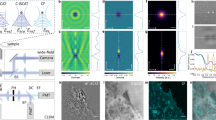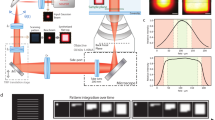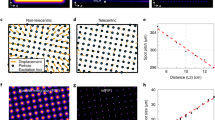Abstract
We describe the usage of the spatially modulated illumination (SMI) microscope to estimate the sizes (and/or positions) of fluorescently labeled cellular nanostructures, including a brief introduction to the instrument and its handling. The principle setup of the SMI microscope will be introduced to explain the measures necessary for a successful nanostructure analysis, before the steps for sample preparation, data acquisition and evaluation are given. The protocol starts with cells already attached to the cover glass. The protocol and duration outlined here are typical for fixed specimens; however, considerably faster data acquisition and in vivo measurements are possible.
This is a preview of subscription content, access via your institution
Access options
Subscribe to this journal
Receive 12 print issues and online access
$259.00 per year
only $21.58 per issue
Buy this article
- Purchase on Springer Link
- Instant access to full article PDF
Prices may be subject to local taxes which are calculated during checkout



Similar content being viewed by others
References
Martin, S., Failla, A.V., Spöri, U., Cremer, C. & Pombo, A. Measuring the size of biological nanostructures with spatially modulated illumination microscopy. Mol. Biol. Cell 15, 2449–2455 (2004).
Mathée, H. et al. Nanostructure of specific chromatin regions and nuclear complexes. Histochem. Cell Biol. 125, 75–82 (2006).
Hell, S.W. & Wichmann, J. Breaking the diffraction resolution limit by stimulated emission: stimulated-emission-depletion fluorescence microscopy. Opt. Lett. 19, 780–782 (1994).
Betzig, E. et al. Imaging intracellular fluorescent proteins at nanometer resolution. Science 313, 1642–1645 (2006).
Hess, S.T., Girirajan, T.P. & Mason, M.D. Ultra-high resolution imaging by fluorescence photoactivation localization microscopy. Biophys. J. 91, 4258–4272 (2006).
Rust, M.J., Bates, M. & Zhuang, X. Sub-diffraction-limit imaging by stochastic optical reconstruction microscopy (STORM). Nat. Methods 3, 793–796 (2006).
Heintzmann, R., Jovin, T.M. & Cremer, C. Saturated patterned excitation microscopy—a concept for optical resolution improvement. J. Opt. Soc. Am. A. Opt. Image Sci. Vis. 19, 1599–1609 (2002).
Gustafsson, M.G.L. Nonlinear structured-illumination microscopy: wide-field fluorescence imaging with theoretically unlimited resolution. Proc. Natl. Acad. Sci. USA 102, 13081–13086 (2005).
Failla, A.V., Spoeri, U., Albrecht, B., Kroll, A. & Cremer, C. Nanosizing of fluorescent objects by spatially modulated illumination microscopy. Appl. Opt. 41, 7275–7283 (2002).
Albrecht, B., Failla, A.V., Schweitzer, A. & Cremer, C. Spatially modulated illumination microscopy allows axial distance resolution in the nanometer range. Appl. Opt. 41, 80–87 (2002).
Wagner, C., Hildenbrand, G., Spöri, U. & Cremer, C. Beyond nanosizing: an approach to shape analysis of fluorescent nanostructures by SMI-microscopy. Optik 117, 26–32 (2006).
Egner, A. & Hell, S.W. Fluorescence microscopy with super-resolved optical sections. Trends Cell Biol. 15, 207–215 (2005).
Jäckle, P. Temperaturstabilisierte Objekthalterung und chromatisches Korrekturelement zur Optimierung eines Zwei-Laser-Wellenfeld Mikroskops. Diploma Thesis, Universität Heidelberg, Heidelberg (1999).
Bridger, J.M., Kill, I.R. & Lichter, P. Association of pKi-67 with satellite DNA of the human genome in early G1 cells. Chromosome Res. 6, 13–24 (1998).
Acknowledgements
This work was sponsored by grants from the German Research Foundation (DFG CR 60/23-1+2) and by the European Commission (EU LSHG-CT-2003-503259 and MEIF-CT-2006-041827).
Author information
Authors and Affiliations
Corresponding author
Supplementary information
Supplementary Manual
Basic equipment setup and alignment procedure (PDF 94 kb)
Rights and permissions
About this article
Cite this article
Baddeley, D., Batram, C., Weiland, Y. et al. Nanostructure analysis using spatially modulated illumination microscopy. Nat Protoc 2, 2640–2646 (2007). https://doi.org/10.1038/nprot.2007.399
Published:
Issue Date:
DOI: https://doi.org/10.1038/nprot.2007.399
This article is cited by
-
Super-resolution microscopy with very large working distance by means of distributed aperture illumination
Scientific Reports (2017)
-
Application perspectives of localization microscopy in virology
Histochemistry and Cell Biology (2014)
-
Combining FISH with localisation microscopy: Super-resolution imaging of nuclear genome nanostructures
Chromosome Research (2011)
-
High-precision structural analysis of subnuclear complexes in fixed and live cells via spatially modulated illumination (SMI) microscopy
Chromosome Research (2008)
-
SPDM: light microscopy with single-molecule resolution at the nanoscale
Applied Physics B (2008)
Comments
By submitting a comment you agree to abide by our Terms and Community Guidelines. If you find something abusive or that does not comply with our terms or guidelines please flag it as inappropriate.



